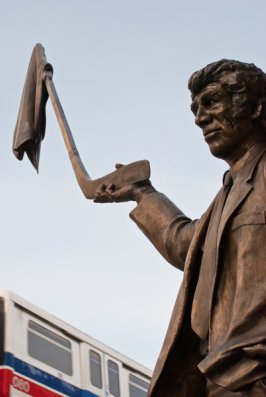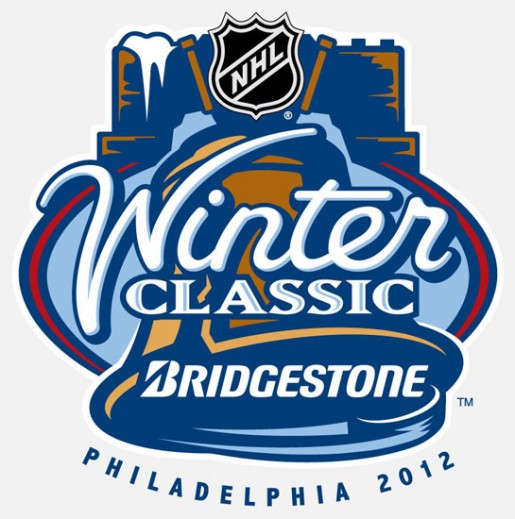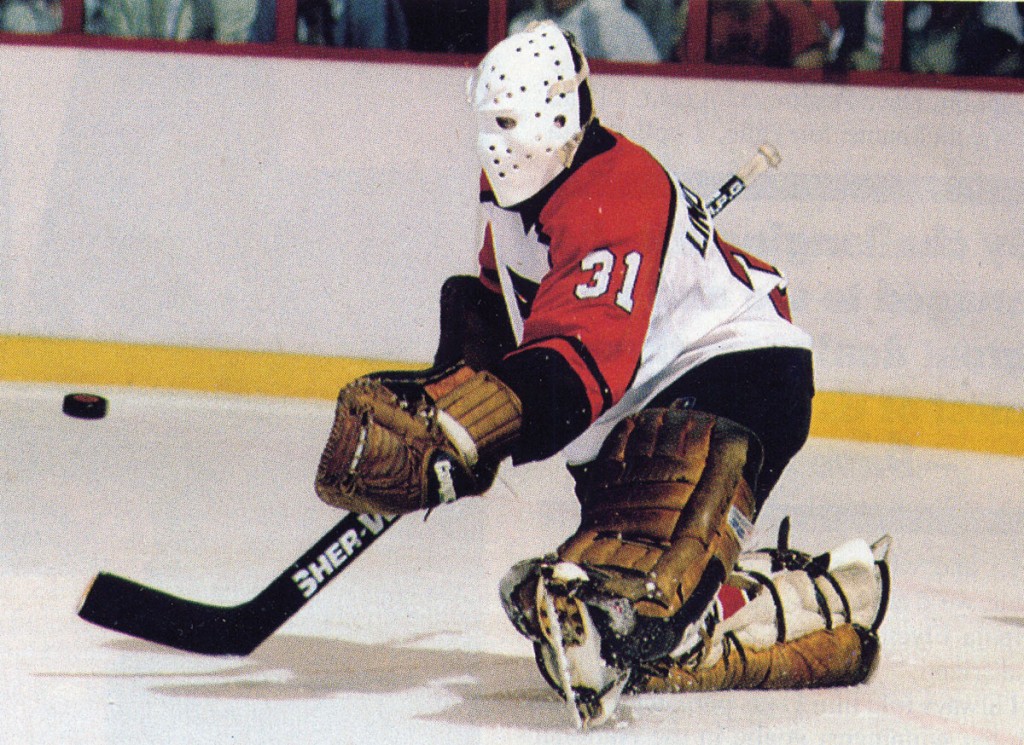An abiding sense of long standing hockey history runs deep for those who bleed Orange and Black. Ed Snider, the head honcho who brought hockey to the blue-collar town of Philadelphia, has seen many talented players walk through the tunnels of the Spectrum and the Core States/First Union/Wachovia/Wells Fargo Center.
When the team was unveiled to the city, the players paraded through town only to notice that roughly 30-50 people had showed up to the event. Seven years later, two million fans showed up to see the Flyers carrying Lord Stanley’s trophy on May 20, 1974. Almost 28 years later, 40,000 people showed up to see some of the greatest players to dawn the Flyers sweater, take it to their arch rivals, the New York Rangers, in a 3-1 win.
The return of Eric Lindros to the “City of Brotherly Love” was magnificent in contrast to the manner in which he left the franchise in 2000. The resentment Philly fans had towards Lindros was all but forgotten as he skated onto the rink for a standing ovation. Paired up with his linemate from the 90s, John LeClair, the two teamed up to pot one of the Flyers three goals on the evening.
A last minute addition was legendary goalie Bernie Parent, who played a mere five minutes in the contest. In those five minutes, he was greeted with cheers from the Philly crowd and played like he did in days of yore, much to the dismay of the New York Rangers. Having led the Flyers to their only two Stanley Cups in franchise history, the adage of “Only the Lord saves more than Bernie Parent” had never rang more true.
For all of the best players that skated on the ice today, there were some who were not able to share the camaraderie of legends (young and old), the festivities, the fans and the overall historical significance of the event that was brought to Citizen’s Bank Park. Some of the most gifted players Ed Snider was able to bring into Philadelphia were with the Flyers in spirit.
Barry Ashbee
Many fans walk into the Flyers arena nowadays and look at the legendary numbers that hang from the rafters. Most notable are the Broad Street Bullies of the 70s. Bobby Clarke, Bill Barber and Bernie Parent are the fixtures that many fans can relate to. But the only other one up on the ceiling is Barry Ashbee’s #4.
The Ontario native was a hard-working, bruising, physical defenseman whose NHL playing career didn’t begin until the ripe age of 31. Any newcomer to Philadelphia sports should remember one thing: the city appreciated effort and determination above skill and finesse. Certainly not one to possess the “WOW!” factor of some of his fellow teammates, Ashbee won over the hearts of Philadelphia fans through his grit and work ethic.
In 284 games, Ashbee had 85 points and 288 penalty minutes (a stat that Philly fans hold dear to their heart). In 1973-74 season, Ashbee’s career came to and end after he took a puck to the eye in a game against the New York Rangers. Ashbee took the job as Assistant Coach of the Flyers the following season to watch the team win their second Stanley Cup in a row. That season, the Flyers decided to retire Ashbee’s number.
In 1977, Barry Ashbee was told he had leukemia and a month later, he succumbed to the dreaded disease. To this day the Flyers hand out the Barry Ashbee Memorial Trophy awarded to the “team’s most outstanding defenseman” as voted upon by a panel of local sportscasters and writers. Although he was not there to play in the Winter Classic Alumni game, it was fitting to see the recipient of the most Barry Ashbee Memorial Trophies representing the Flyers, Eric Desjardins.
Brad McCrimmon
A career that spanned 18 NHL seasons, if there was any defenseman who you really didn’t want to go up against in the 80s, it was Brad McCrimmon. Given the nickname “Beast”, McCrimmon was one of the best stay-at-home defenseman on any given night. Three years after being selected by the Boston Bruins, the Philadelphia Flyers decided to take a flyer (no pun intended) on the defensive stalwart. When he came to the team, he was paired with future hall-of-famer, Mark Howe.
The two endured the challenges that any top defensive pairing have to accept – that they would be playing against the opposing team’s top players night in and night out. They both did admirably leading the team to the Stanley Cup Finals in 1987. Although they lost to the powerhouse Oilers, McCrimmon would go on to win the Stanley Cup with the Calgary Flames and the Detroit Red Wings as an Assitant Coach in 2009. Taken from Adam Kimelman’s column (found here), Howe had this to say about his playing days with McCrimmon:
“We were (a combined) plus-200 in three years. I don’t think Brad ever got the credit he deserved. Brad was a very quality hockey player, but just because players are great players doesn’t mean they play well together. We had a great chemistry. We roomed together — we basically did everything together. It was great. You never had to think the game, everything was instinct. We knew where each other was going to be. And even though we’d both screw up, have bad nights, nobody every pointed the finger at each other. We’d always take the blame even if maybe the other guy deserved it. We were true teammates in every sense of the word.”
Brad McCrimmon took a head coaching gig with Yaroslavl Lokomotiv in the KHL. On Wednesday, September 7, 2011, Yaroslavl’s team plane hit a tower mast and crashed, taking the lives of everyone in the plane – McCrimmon included. A tragic day in all of sports, McCrimmon’s legacy as a player and coach will always be remembered for what he did on and off the ice.
Pelle Lindbergh
Some Flyers fans argue that Pelle Lindbergh was better than Bernie Parent. Some Flyers fans argue that if Pelle hadn’t passed away prematurely, their would have been a few more parades down Broad Street.
No matter the disagreement, Pelle Lindbergh was the quintessential Flyer. Born in the Swedish capital of Stockholm, Pelle began his playing career for the local Hammarby Youth team. When he was 5, Lindbergh received his first set of goalie equipment. Curt Lindstrom, a former Swedish coach for the National Team, showed young Pelle a film of Flyers goaltending great, Bernie Parent, during the teams 1975 Stanley Cup Final.
Immediately, Pelle became enamored with the goaltending legend and modeled his game after Parent. So focused on achieving success as Parent did, Lindbergh’s favorite team became – you guessed it – the Philadelphia Flyers. Lindbergh even wore a mask that eerily resembled Bernie’s with a Flyers logo painted on the top. So as a hockey fan, you can imagine the delight that surrounded Pelle when, in 1979, the Philadelphia Flyers selected him in 2nd round of the NHL draft.
Lindbergh went on to represent Team Sweden in the World Junior Championships twice, winning silver in 1978 and bronze in 1979. A year later, Pelle was called on to be Sweden’s goalie for the Olympics in Lake Placid. Backed by Lindbergh’s performance in net, Sweden captured bronze. He spent five seasons with the club.
During his tenure, he was selected to the NHL’s All-Rookie Team in 1983. A year later, Lindbergh became the first European goalie to win the Vezina Trophy as the league’s best goaltender. A little known fact about Lindbergh is that he was the first goalie to put a water bottle on the top of the net because he often suffered from dehydration.
However, all did not turn out as planned. In the early hours of November 10, 1985, Pelle Lindbergh crashed his Porsche 930 Turbo into a wall in Somerdale, New Jersey, killing himself and injuring two others in the car. It was determined by local police that Lindbergh’s blood alcohol content at the time of the crash was .24%. The legal limit in New Jersey at the time was .10%. Since then, no one in a Flyers locker room has worn the number 31, as it has been “unofficially” retired by the Philadelphia Flyers.
Although Flyer fans were deeply saddened by the death of one of their own, Lindbergh left and indelible mark on the Flyers as one of the best goalies to suit up between the pipes in Philadelphia’s history.
Roger Neilson

Regardless of who plays on the ice, if you don’t have a coach, you don’t have a team. Growing up infatuated with hockey during the 90s, there was no better coach for the Flyers than Roger Neilson. As a young fan, I didn’t care much for how the game was played, but what vividly stood out in my mind were the bright, colorful, sometimes wacky ties that Neilson would wear to each game.
Neilson started coaching with the Peterborough Petes in 1966 before joining the Maple Leafs in 1977. The 20 years that followed, Neilson found himself behind the bench in Buffalo, Vancouver, Los Angeles, New York and Florida. In 1998, he took over as coach of the Flyers. The soft-spoken coach led the Flyers to a 92-48-31 record before moving to Ottawa to finish out his career.
An innovator in the game of hockey, Neilson was one of the first to implement video tape to analyze other teams tactics, plays, and style to gain the advantage come game day. Because of this, he was given the nickname “Captain Video”.
Neilson was diagnosed with bone cancer in 1999, which eventually became skin cancer. In 2001, as the assistant coach of the Ottawa Senators, Jacques Martin stepped down as head coach for the remaining two games of the regular season to let Neilson coach. The significance of this was that Neilson had coached 998 games as head coach up to that point. Having coached the last two games, Neilson became the ninth to coach 1000 games.
In November of 2002, Neilson was inducted into the Hockey Hall of Fame as a member of the “builder” category. On June 21, 2003, Roger Neilson passed away from his battle with cancer. As a fantastic coach, mentor and innovator, it would have been great to see Roger Neilson behind the bench for the Flyers today.

